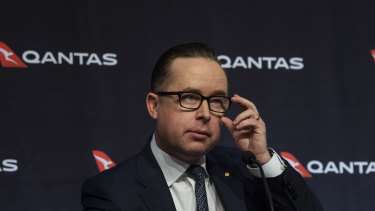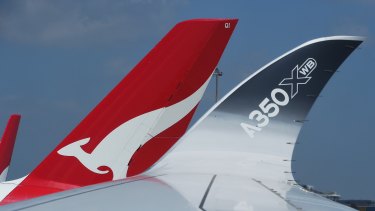Qantas’ remarkable turnaround comes with a lingering hangover for Joyce
Qantas chief executive Alan Joyce walks a thin line. He has to balance his success at the remarkable prospect of turning the airline cash flow positive in late 2021 with a reminder to shareholders that the COVID balance sheet hangover could take time to clear.
At the same time Joyce has to justify the loss of thousands of jobs and the desire for further concessions on pay and conditions for those that remain.
Joyce deserves the crown among chief executives of large Australian companies for relentless cost-cutting – not just in response to COVID but over the previous five years.

It is quite remarkable that an airline that will have lost $11 billion in revenue in financial year 2021 will, in the first half (to December 2020), manage to produce earnings before interest, tax, depreciation and amortisation that are flat against the previous corresponding period that pre-dated the pandemic.
It is equally astonishing that an airline that was bleeding cash at the rate of $40 million a week during peak-virus is anticipating it will be cash flow positive in the second half of the 2021 financial year (to June 2021).
The bottom line result will still be a statutory loss in 2021 – the non-cash item of depreciation will be in part responsible and additional redundancy costs will also kick in, thus ensuring the result will be inked in red.
And this degree of financial recovery will be achieved without any contribution from its international flying division.
As Qantas sees it, the airline is now out of the intensive care unit but the financial rehabilitation will be a long process.
And this applies particularly to the airline’s balance sheet. Since the start of the pandemic Qantas has raised around $2.7 billion in gross debt some of which has been used to pay off other debt and it is currently sitting on net debt of $5.9 billion even after a $1.4 billion equity raising.
Still, Joyce is planning to add another $500 million to the group’s liquidity buffer – just as a contingency and if all goes to plan it will not bge needed. So Joyce’s position could be best characterised as one of cautious optimism.
He cannot afford to approach the airline’s prospects based on the assumption the recovery will move in a straight line.
Recent history has clearly demonstrated that the risks of viral spot fires are real and the responses from state governments to close borders have thrown a spanner in plans to re-open the skies.
As of next week, when Western Australia removes the wall to the rest of the country, the federation will return but it can’t be relied on.
Therefore, Joyce’s operational and financial update was based on how it is looking at this point.

Thanks in large part to the opening of Queensland and Victoria, Qantas’ capacity is up to 68 per cent for the month of December and will rise to 80 per cent in the three months from January to March.
Joyce says that in the first six months of calendar year 2021 the process of balance sheet repair will begin. But realistically tackling debt in a meaningful way can’t begin until the international division takes off – which is slated to happen in the middle of next year.
Only then will Qantas even begin to dust off the Sunrise plan to run non-stop services from Australia’s east coast to New York and London. Even if Sunrise is revisited it will take three to four years to achieve take-off.
Realistically with balance sheet repair at the top of the to-do list, Qantas’s capital expenditure plans would be towards the bottom. Where resumption of dividends sits is unclear.
The more immediate concern for Qantas is how the new-look Virgin tackles the market. It is a little early to see where Virgin’s fare pricing will land but its cost base is starting to take form with news this week it has negotiated its enterprise bargaining agreements.
Joyce makes no secret of the fact that he will be looking to the industry’s various unions to match any deals Virgin has extracted from its workforce.
Virgin’s time in administration allowed it to significantly cut its cost base, which will allow it to undercut Qantas on price.
The good news is that Virgin 2.0 is a smaller airline with less capacity and a reduced route structure.
Joyce’s challenge is to improve on its current 70 per cent market share. It has already poached 25 major corporate accounts from Virgin but the real prize for either airline is the SME market which-make up the bulk of corporate travellers.
Joyce says the business market has come back quite strongly since the Sydney/Melbourne/Brisbane (aka the golden triangle) has reopened. But it will need to increase the share on these routes to offset an overall decline in business travel that has resulted from the popularity of virtual business meetings.
In the business market, Zoom will be as fierce a competitor as Virgin or Rex.
Business Briefing
Start the day with major stories, exclusive coverage and expert opinion from our leading business journalists delivered to your inbox. Sign up here.
Elizabeth Knight comments on companies, markets and the economy.
Most Viewed in Business
Source: Thanks smh.com